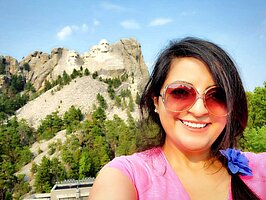Hydraulic and hydrologic routing parameters in natural channels in North Dakota under spring snowmelt conditions

Vida Atashi is Ph.D. student in Civil Engineering conducting the research in this proposal under the advisement of Dr. Yeo Howe Lim. Dr. Lim is a Professor at the University of North Dakota in the Civil Engineering Department. She attended her B.S. and Master in Shahid Chamran University, Iran in Water Engineering and Hydraulic Structures, respectively. As an undergraduate, she received a firm training in both subjects of hydraulics and hydrology and was exposed to a variety of research methods. As a master student, she was trained in hydraulic and hydrological field studies: She wrote several papers about hydraulic structures, harvesting energy from hydraulic structures and river engineering conservation. She has been working with Dr. Lim to develop her Ph.D. research topic. Her current proposed research is characterizing flood flow in natural channels in North Dakota and focusing on verifying hydraulic and hydrologic routing parameters under spring snowmelt conditions.
Hydraulic and hydrologic routing parameters in natural channels in North Dakota under spring snowmelt conditions
Snowmelt is one of the processes intervening in the hydrological cycle and interacting with many other processes. Hydrological processes related to snow occur in large regions of the earth including North Dakota and relationship with runoff coming from snowmelt is recurrent. The Muskingum model is one of the most popular models for hydrologic channel flood routing. Two case studies are to be investigated: (1) methodology is proposed to estimate the parameters of Muskingum model using the basin characteristics representing the inlet and outlet of the channel reach (two stations in Red River, Grand Forks) and (2) the changes in the water elevations of two selected lakes connected by a natural channel (between Devils Lake and Stump Lake, North Dakota). This result will lead to (1) derive useful hydrologic routing for channels and allow better prediction of the hydrologic conditions of watershed runoff at outlet location and (2) characterize the hydraulic conditions of the two lakes that are connected through a natural channel. The outcomes will enable us to provide accurate flood forecasting for the coming years by flow routing with observing hydraulic and hydrologic data in the field, collecting past records from published data, modeling using hydrologic and hydraulic software.
Project Objectives:
The purpose of this project is to investigate the behavior of various streams and lakes configurations that present challenging problems in flood forecasting, lag time, and design parameters. Two case studies are to be investigated: (1) the changes in the water elevations of two selected lakes connected by a natural channel, and (2) the impacts of morphology of several selected natural channels in river reaches subjected to flooding during the past years.
The work will involve observing hydraulic and hydrologic data in the field, collecting past records from published data, modeling using hydrologic and hydraulic software (such as HEC-RAS and HEC-HMS). I will be able to: (1) characterize the hydraulic conditions of the two lakes that are connected through a natural channel, and (2) derive useful hydrologic routing for channels and hence allow better prediction of the hydrologic conditions of watershed runoff at an outlet location. These understanding will allow formulation of strategies to mitigate flooding in many areas.
Progress:
Research has just started in the first semester at UND.
This research consists of field measurements and computer modeling. A device will use to measure hydraulic parameters, in an appropriate cross section. The best location with the best with and the optimum hydraulic section to choose for investigation should be determined. To reach the specific location to collect hydraulic data, HYCAT will be used. The HYCAT Autonomous Surface Vehicle (ASV) is the newest element in the Xylem brand Autonomous and Remote Vehicle Monitoring Solutions. This remotely controlled vehicle is capable of measuring water depth, velocity, and water quality. It also has side scan sonar, bathymetry, Remote Data Acquisition and real time positioning. Dr. Lim has acquired the state-of-the-art instrument under an NSF MRI grant in 2019. The analysis will use data from the HYCAT which collect the data from natural channel between two mentioned lakes and at cross sections specified for channel routing investigations. The HYCAT can also be easily deployed with two people in remote locations, not requiring ramp/dock launch access.
Significance:
The anticipated result would be categorized as:
- Understand the impacts of morphology of natural channels between the two lakes on water levels in the lakes in the upcoming years
- Obtaining equations for estimating hydrologic routing coefficients: x and k in Muskingum Method for channel routing in streams of North Dakota
- Calculate time lag for runoff and flood peak time
- Anticipate the necessity for any hydraulic structures between the two rivers if needed
- Calibration of new rating data in comparison with USGS data in the selected stations
Conference/Seminar Presentations:
Atashi, V. , Lim, Y. H., Khajavi, M., and Shafai-Bajestan, M. (2020) “Characteristics of Hydraulic Jumps in Stilling Basins with Permeable Six-Legged Elements.” Proc., World Environmental and Water Resources Congress 2020, Hydraulics, Waterways, and Water Distribution Systems Analysis, p 65 -75. https://doi.org/10.1061/9780784482971.007
Atashi, V. and Lim, Y.H. “Routing Velocity and Water Level in A Flood Caused by Dam Break in a Mild Bends.” World Environmental and Water Resources Congress 2021. (accepted, in progress)

Lim Yeo Howe
Civil Engineering
Upson Hall II Room 260D
243 Centennial Drive Stop 8115
Grand Forks, ND 58202-8115
Phone: 701-777-3998
Email: yeo.lim@und.edu


